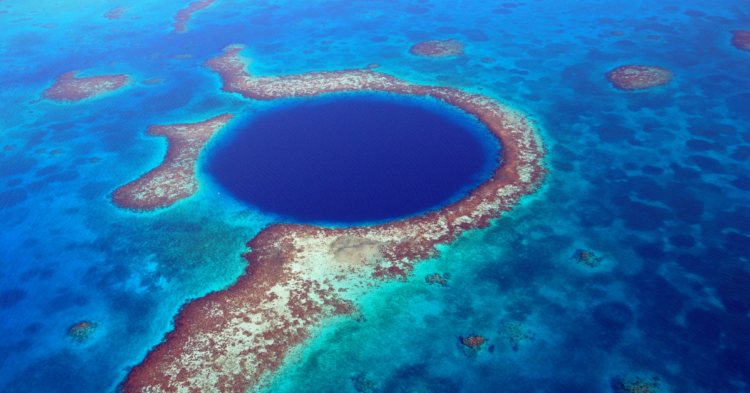You’ve probably seen pictures of the Great Blue Hole in Belize. It’s an enormous marine sinkhole at the center of an atoll, about 43 miles off the coast of the Central American country. Needless to say, it’s a beautiful sight. But what appears to be pristine natural beauty reveals a much bleaker story when viewed up close.
It’ll forever be associated with marine adventurer Jacques Cousteau.

In his 1970s heyday, Cousteau studied the Blue Hole, making significant discoveries about its geologic makeup, depth and even how the hole came to be (basically, it’s a cave that flooded when ocean levels rose).
It’s been a popular tourist destination ever since.

The crystal-clear water, tropical flora and fauna and overall “tropical paradise” vibe give tourists every reason to want to visit. Typically, boats go out from Belize City and take people to the Hole for day trips.
The Blue Hole has problems, though.

Our oceans are in rough shape in many ways, and the Blue Hole is no exception. In late 2018, a new expedition — helmed by a familiar name — sought out to get to the bottom of things.
The mission was led by Fabien Cousteau.

Conservationist, oceanographer, adventurer — and grandson of the legendary Jacques —Cousteau went to Belize with The Discovery Channel to investigate the bottom of the Blue Hole in a custom built submersible.
The mission was the first of its kind.

Although his grandfather explored the Blue Hole, Fabien Cousteau intended for his submersible to be the first craft to reach, and chart, the bottom of the Blue Hole, which lies more than 400 feet below the ocean surface.
He brought a famous friend.

The sub crew included Cousteau, submarine pilot Erika Bergman and investor/philanthropist/billionaire/man-about-town Richard Branson. Since the Blue Hole is basically a complex cave system, reaching the bottom is no easy feat.
The light down there is otherworldly.

While Cousteau, Branson and Bergman were plenty excited to explore the Blue Hole. But once the excitement wore off, the current state of this natural wonder paints a pretty grim picture for the future.
Things aren’t so clear once you’re underwater.

Layers of hydrogen sulfide and other gases made the trek to the bottom less straightforward than most submersible trips. But thanks to the expert guidance of Bergman, they did eventually reach the bottom.
Branson detailed the problems in a blog post.

He wrote a super-detailed account, which is well worth a read. “As for the mythical monsters of the deep?” he asked, “Well, the real monsters facing the ocean are climate change — and plastic.”
Plastic is a huge problem with our oceans.

Branson sounded the alarm about single-use plastics — which are used once, then discarded, taking thousands of years to break down — in his post. “With every item we buy, every piece of food we serve, the environmental impact is paramount,” he stressed.
Conservationists are trying to change things.

Cousteau and Branson, both conservationists, want to turn things around before it’s too late. Their expedition, and the resulting Discovery Channel documentary, are just part of raising overall awareness about pollution in the oceans.
It’s more than just plastic.

Branson wrote that the team encouraged the Belizean government to protect 10 percent of the country’s waters, along with banning gill nets, which tend to be catastrophic to marine wildlife.
The oceans drive life on our planet.

They’re easy to forget about — after all, we live on land. But ocean currents and ocean flora and fauna have a knock-on effect that influences everything. If we destroy the oceans, we destroy ourselves.
Branson wants to protect more of the ocean.

He’s set the goal of protecting at least 30 percent of the ocean by 2030. Considering it’s just a bit over a decade away, and most countries protect very little of their waters, it’ll be a tough task.
The world’s oceans are beautiful — and they’re in trouble.

Branson wrote, “My grandchildren will be in their thirties by 2050. I don’t want them to grow up in a world without corals, without the wonders of the ocean.”

















































